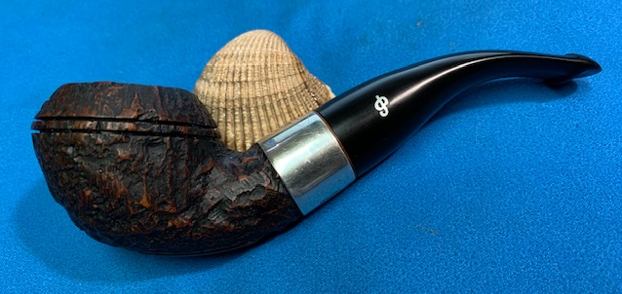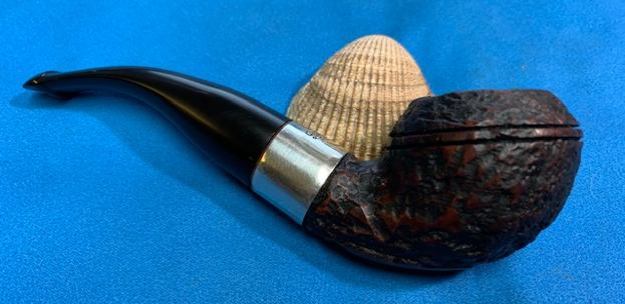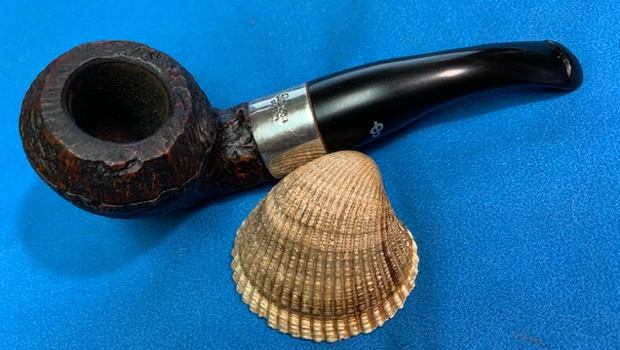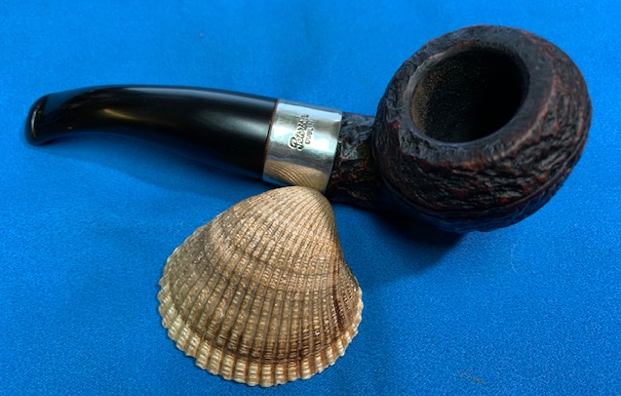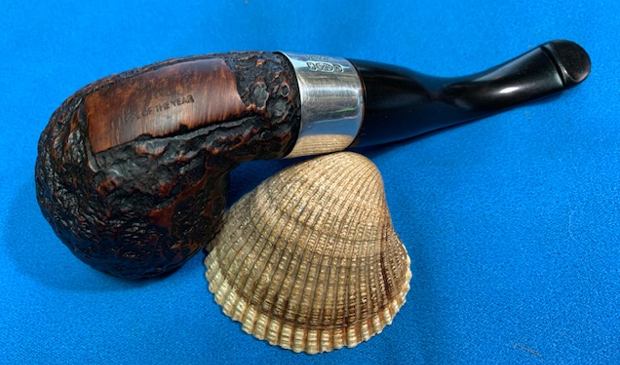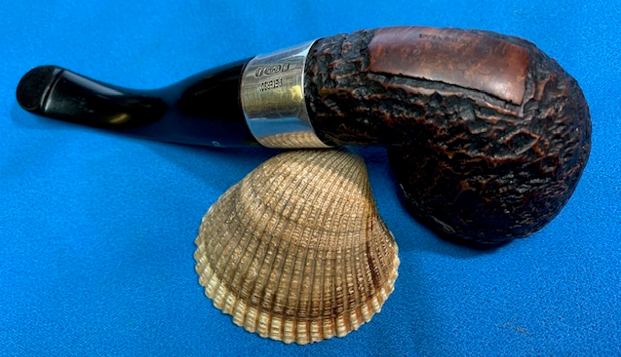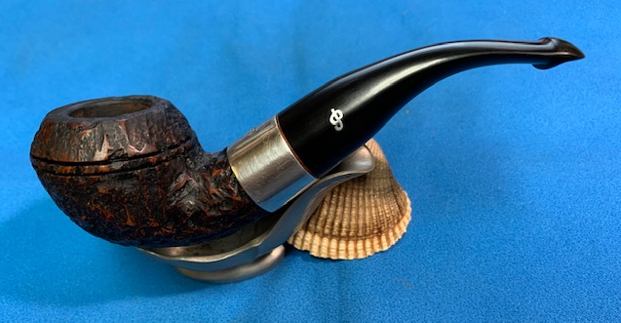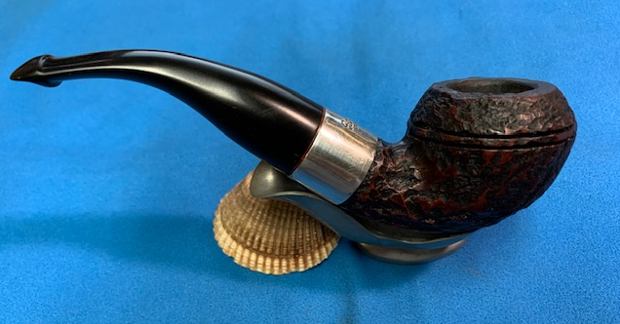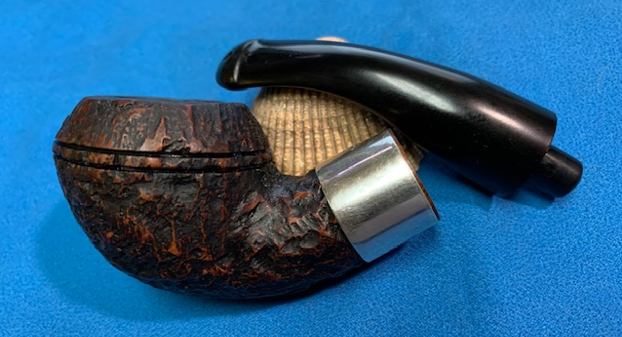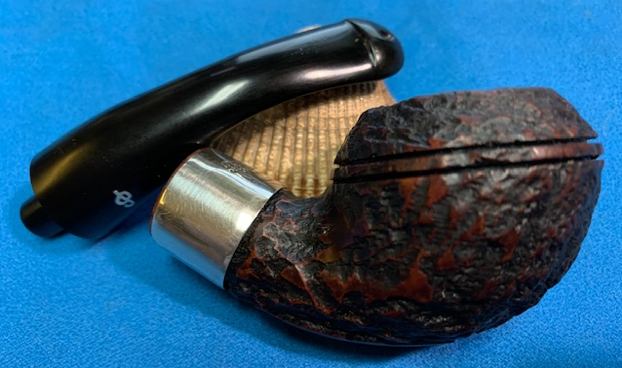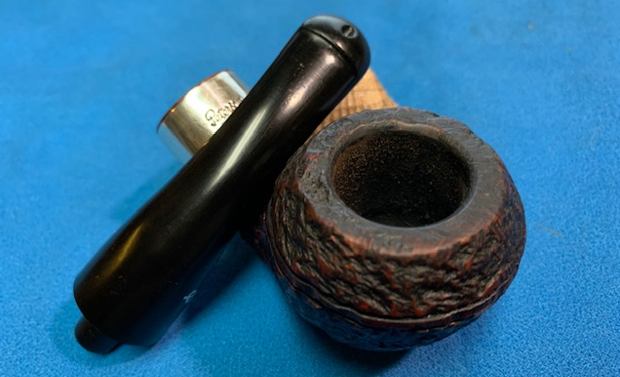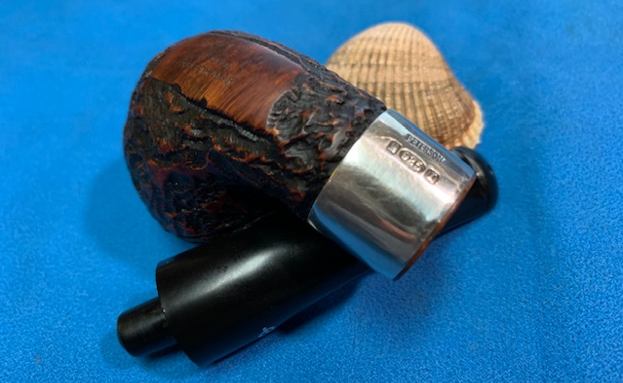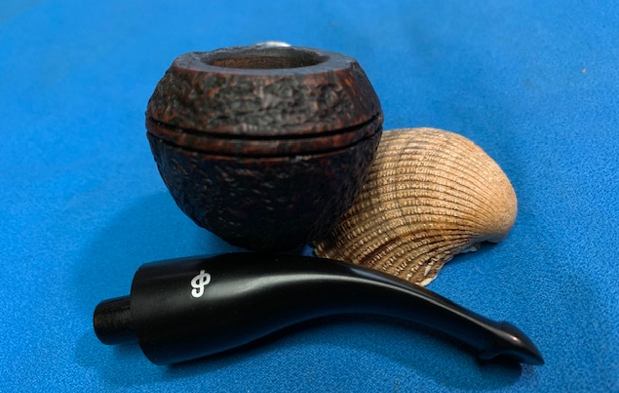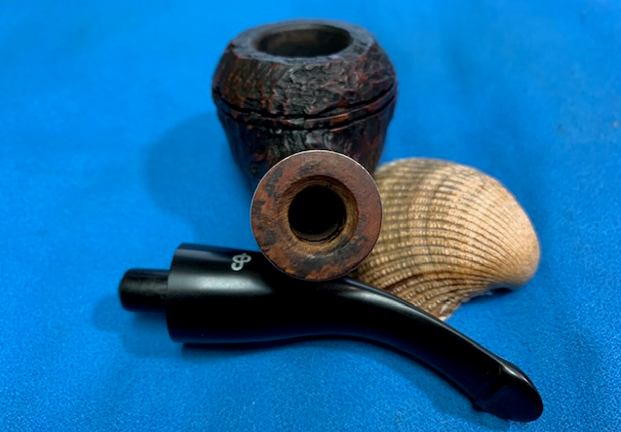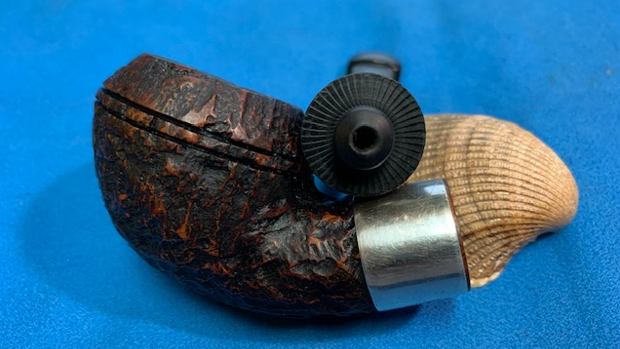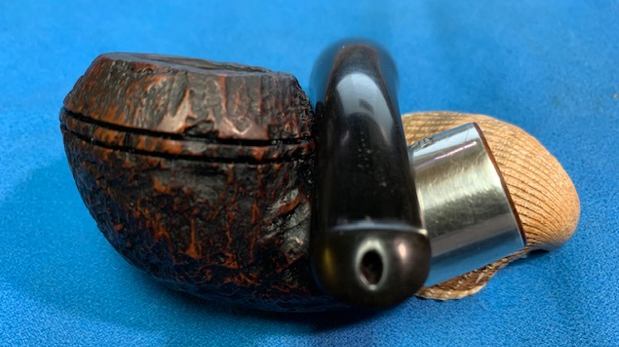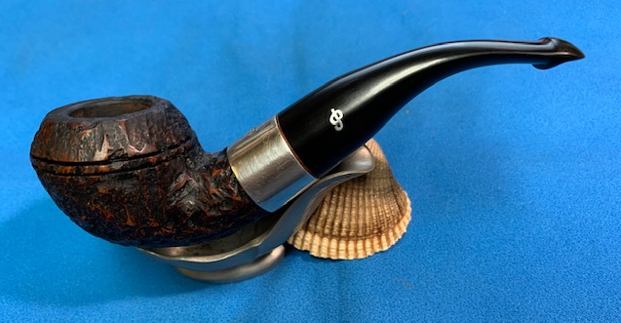Blog by Steve Laug
Yesterday a friend stopped by with a pipe he wanted me to have a look at and “spruce up” for him. He arrived in the heat of the day just before 5pm which is when it seems to be the hottest time here in Vancouver. He took the pipe out of his back pack and it was in the classic green Peterson of Dublin bag. He told me that he had picked it up at the Peterson’s shop in Dublin when he was there. It was hot out and he was with a friend so we did not go into details. The pipe appeared to be rusticated and looked to me like a Donegal Rocky in one of my favourite shapes – a Rhodesian 999. The bowl had a moderate cake and some lava on the rim top that needed attention. The rustication was dirty with dust of time ground in to the finish. The stem did not fit correctly in the shank. It should have been snug against the silver band but it was not. The silver “P” logo-ed stem was not too bad – no oxidation or build up. It had tooth chatter on both sides around the button. I took the pipe in and told him I would work on it and get back to him.
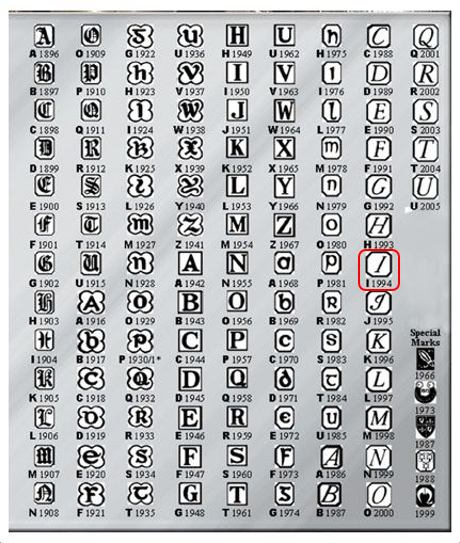 It was only later the next morning that I started working on it. I wanted to know what I was dealing with so I examined the faint stamping on the smooth panel on the underside of the shank. It read Peterson [arched over] OF DUBLIN [arched over] PIPE OF THE YEAR. There was no other stamping on the shank – no shape number and no year! I turned my attention to the silver band on the shank. It was a band and not a ferrule. It was stamped on the top and read Peterson [over] Dublin. On the underside it was stamped Peterson over three hallmarks – Hibernia seated (on the left) followed by 925 in an oval followed by an italic upper case “I”. That gave me the needed information. The Hibernia stamp identified it as made in Ireland, the 925 stamp was the quality of the silver and the italic I was the year. From the chart above that identified it as having been made in 1994 – at least the band was! I have drawn a red box around it in the above photo.
It was only later the next morning that I started working on it. I wanted to know what I was dealing with so I examined the faint stamping on the smooth panel on the underside of the shank. It read Peterson [arched over] OF DUBLIN [arched over] PIPE OF THE YEAR. There was no other stamping on the shank – no shape number and no year! I turned my attention to the silver band on the shank. It was a band and not a ferrule. It was stamped on the top and read Peterson [over] Dublin. On the underside it was stamped Peterson over three hallmarks – Hibernia seated (on the left) followed by 925 in an oval followed by an italic upper case “I”. That gave me the needed information. The Hibernia stamp identified it as made in Ireland, the 925 stamp was the quality of the silver and the italic I was the year. From the chart above that identified it as having been made in 1994 – at least the band was! I have drawn a red box around it in the above photo.
I took photos of the pipe before I started my work on it. These photos confirm the conditions noted above. The stem did not fit properly and my friend said it had been that way since he purchased it. The bowl was caked and the rim top had some lava overflow. The stem was clean other than the tooth chatter on both sides ahead of the P-lip button. It really was a nice looking pipe with a rugged rustication like the Donegal Rocky.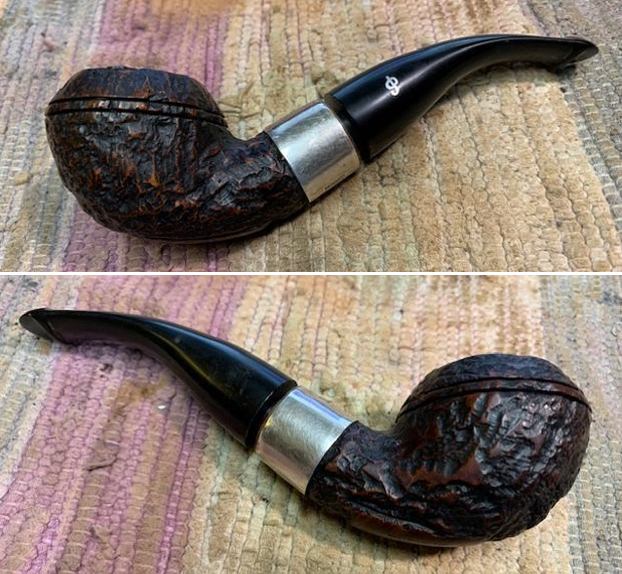
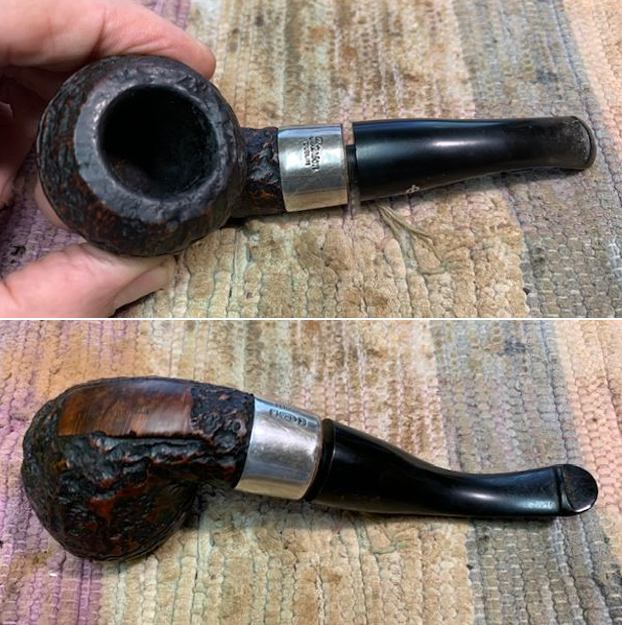 I took a photo of the rim top and bowl to show the cake and the lava on the top. The first photo shows the gap where the stem does not fit the shank correctly. The stem photos show the tooth chatter on both sides.
I took a photo of the rim top and bowl to show the cake and the lava on the top. The first photo shows the gap where the stem does not fit the shank correctly. The stem photos show the tooth chatter on both sides.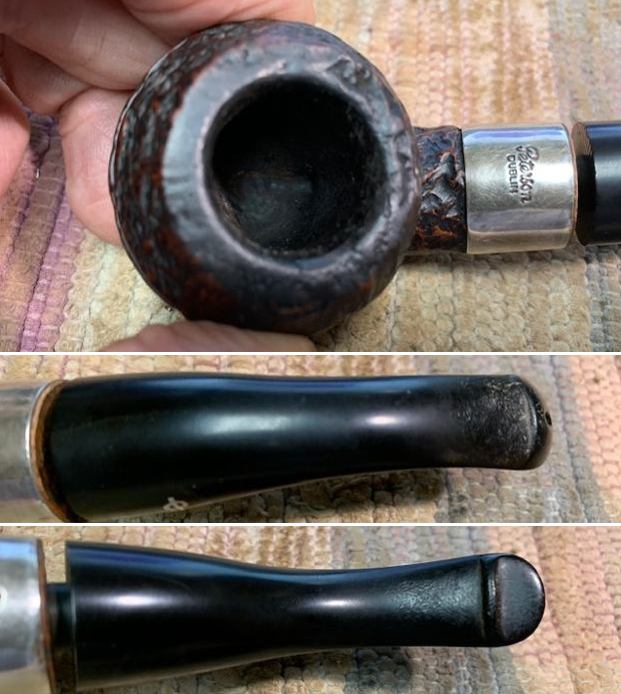 I took photos of the stamping on the underside of the shank and the band. They read as noted above. You can see the shape of the cartouche on each of the hallmarks.
I took photos of the stamping on the underside of the shank and the band. They read as noted above. You can see the shape of the cartouche on each of the hallmarks.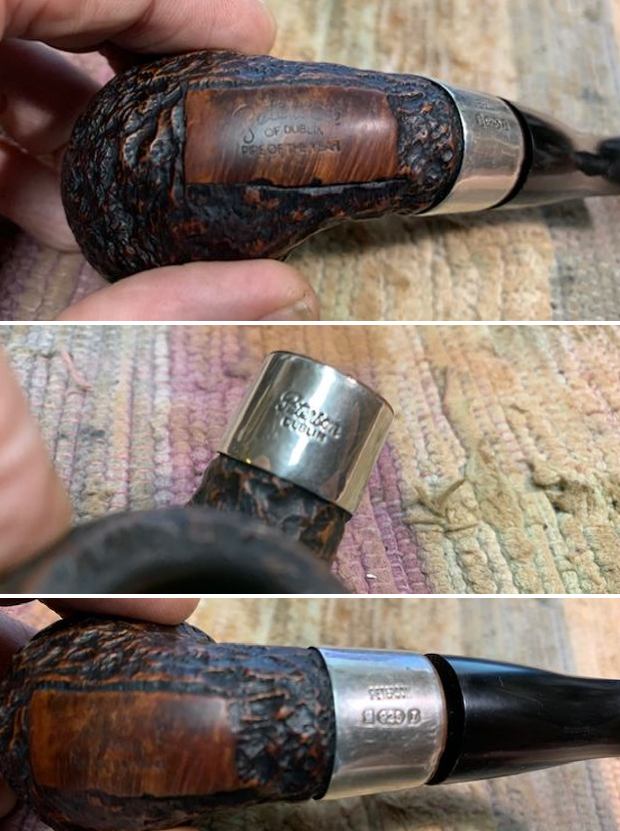 I started my work on the pipe by reaming the bowl with a Savinelli Fitsall Pipe Knife. I scraped the uneven cake back to bare briar so I could examine the walls on the bowl. It was in good condition. I used a brass bristle wire brush to scour off the lava on the rim top. It had filled in some of the rustication so the brush removed much of that.
I started my work on the pipe by reaming the bowl with a Savinelli Fitsall Pipe Knife. I scraped the uneven cake back to bare briar so I could examine the walls on the bowl. It was in good condition. I used a brass bristle wire brush to scour off the lava on the rim top. It had filled in some of the rustication so the brush removed much of that. 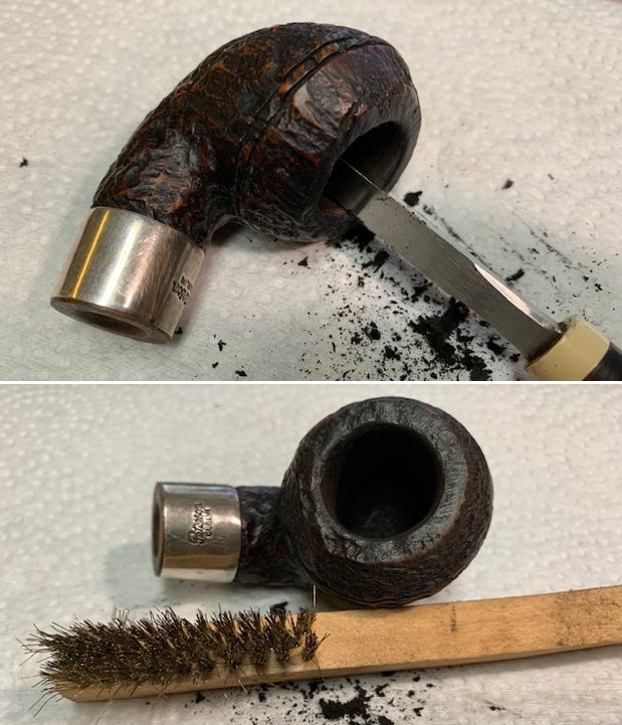 I scrubbed the rim top and the outside of the bowl and shank with a tooth brush and undiluted Murphy’s Oil Soap. I rinsed the bowl under running water to rinse off the soap and the debris. The bowl is beginning to take on a great look and the contrasting stains show well.
I scrubbed the rim top and the outside of the bowl and shank with a tooth brush and undiluted Murphy’s Oil Soap. I rinsed the bowl under running water to rinse off the soap and the debris. The bowl is beginning to take on a great look and the contrasting stains show well.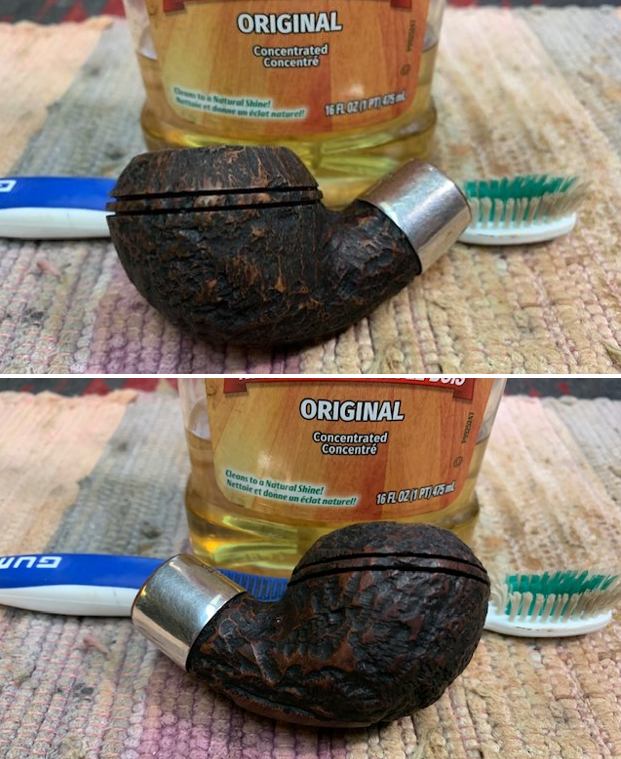
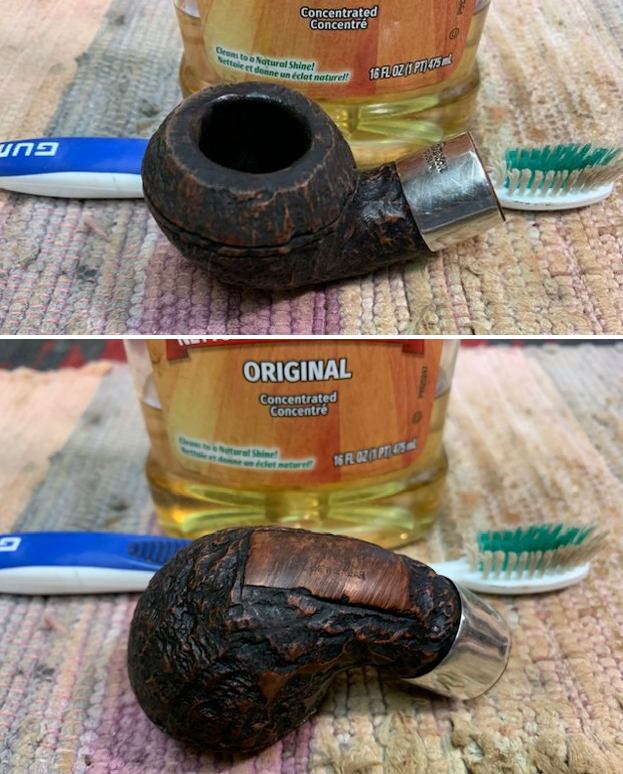 I cleaned out the airway in the shank and the stem with 99% isopropyl alcohol, cotton swabs and pipe cleaners. I cleaned out the mortise carefully and was able to remove some stain and rubbish there that kept the stem from seating properly.
I cleaned out the airway in the shank and the stem with 99% isopropyl alcohol, cotton swabs and pipe cleaners. I cleaned out the mortise carefully and was able to remove some stain and rubbish there that kept the stem from seating properly.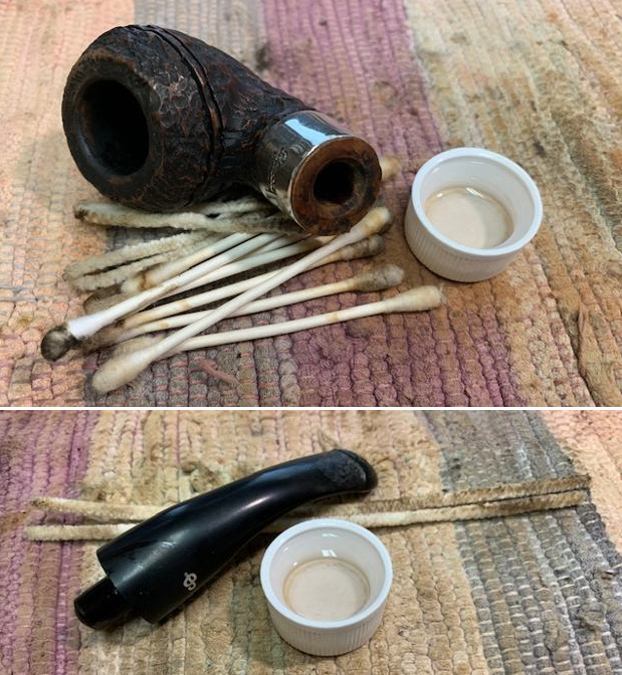 I worked some Before & After Restoration Balm into the surface of the briar with my finger tips. I worked it into the crevices of the rustication with a horsehair shoe brush. The product continues to amaze me with it capacity to clean, enliven and protect the briar. I let it sit on the bowl for 10 minutes and then buffed it off with a soft cotton cloth. It is looking very good at this point.
I worked some Before & After Restoration Balm into the surface of the briar with my finger tips. I worked it into the crevices of the rustication with a horsehair shoe brush. The product continues to amaze me with it capacity to clean, enliven and protect the briar. I let it sit on the bowl for 10 minutes and then buffed it off with a soft cotton cloth. It is looking very good at this point.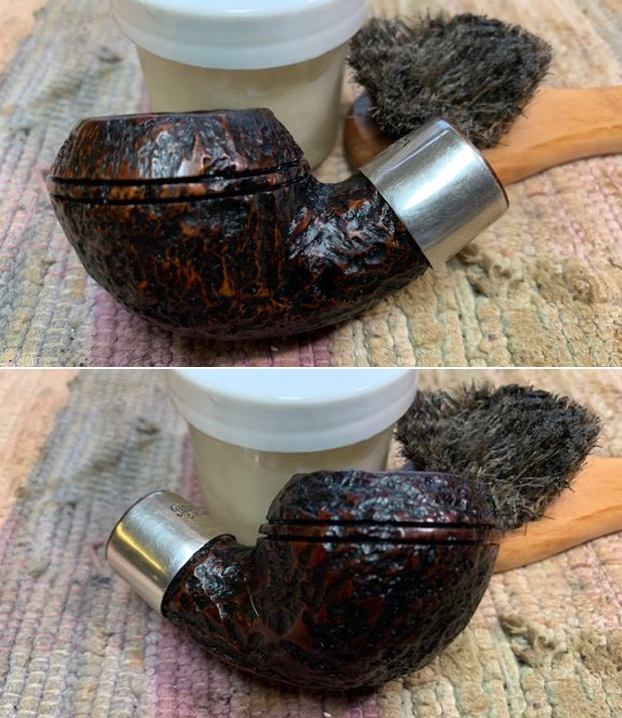
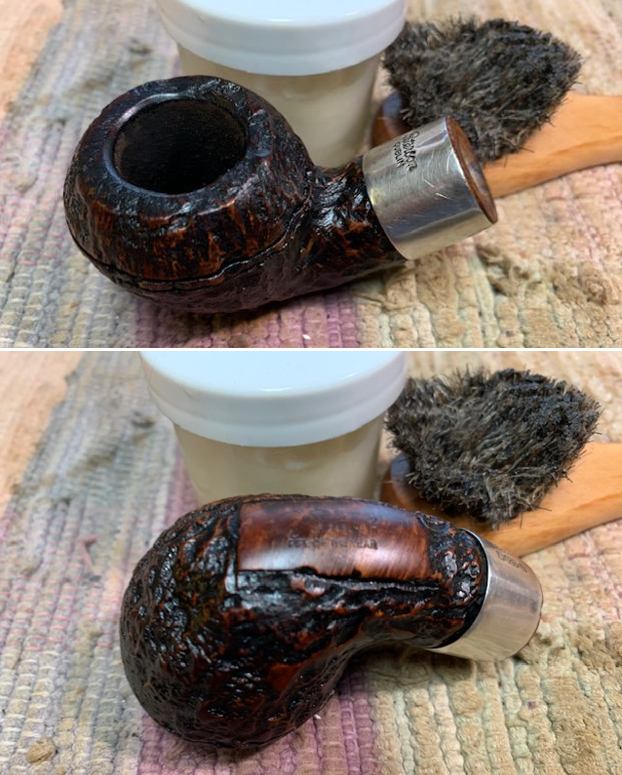
 I polished the silver band with a jewelers cloth to remove the light tarnish and give it a deep shine.
I polished the silver band with a jewelers cloth to remove the light tarnish and give it a deep shine.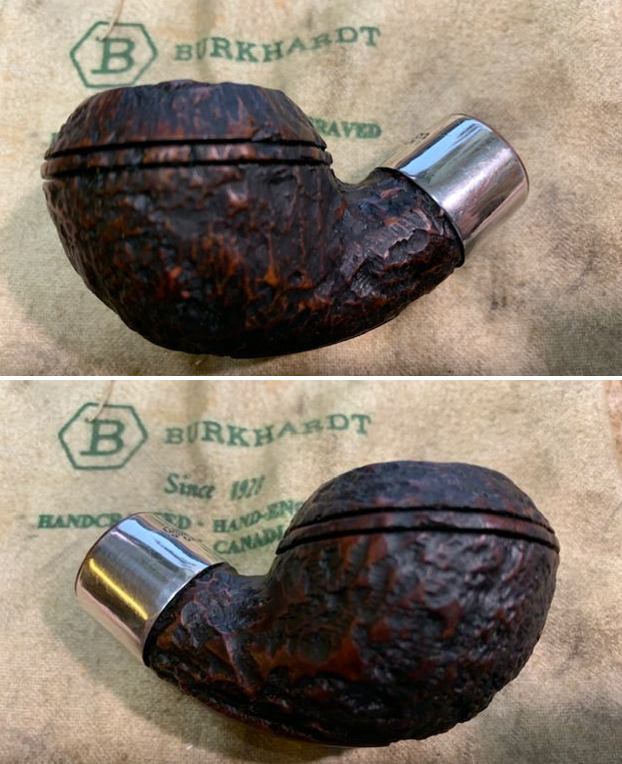
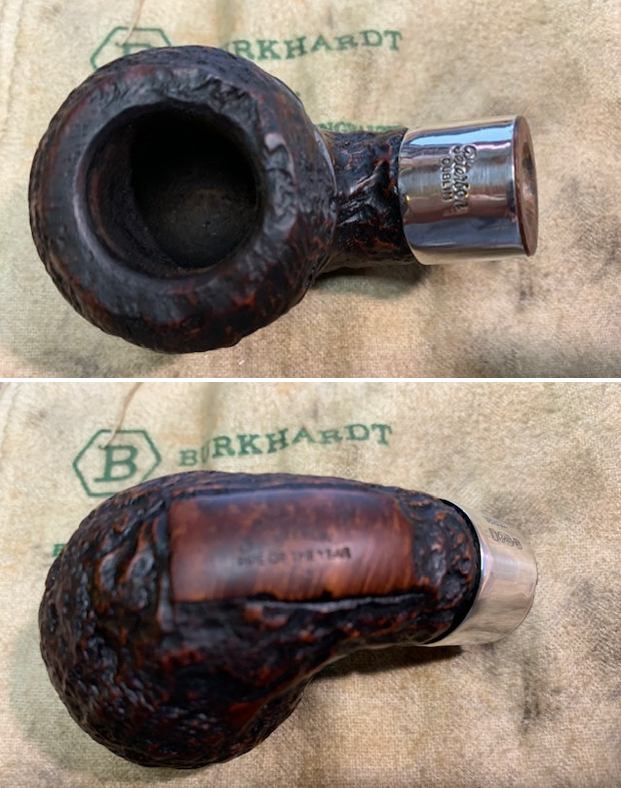 I set the bowl aside and turned my attention to the stem. I sanded out the tooth marks on the top and underside with a folded piece of 220 grit paper.
I set the bowl aside and turned my attention to the stem. I sanded out the tooth marks on the top and underside with a folded piece of 220 grit paper.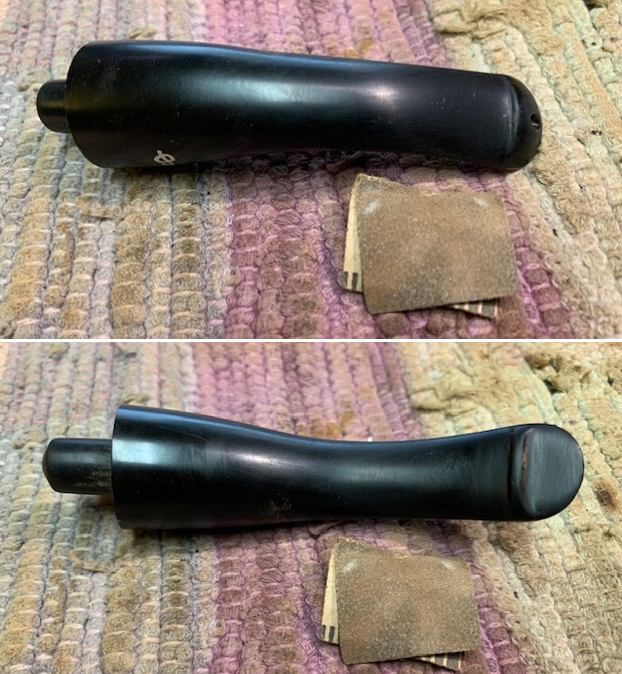 I noticed that the tenon was a little larger in diameter at the stem end than the shank end. I would need to reduce it to the same diameter the entire length of the tenon for the fit to be right in the shank. I used a small file to work over the tenon. Once it was the right diameter I started the polishing of the tenon with 220 grit sandpaper.
I noticed that the tenon was a little larger in diameter at the stem end than the shank end. I would need to reduce it to the same diameter the entire length of the tenon for the fit to be right in the shank. I used a small file to work over the tenon. Once it was the right diameter I started the polishing of the tenon with 220 grit sandpaper.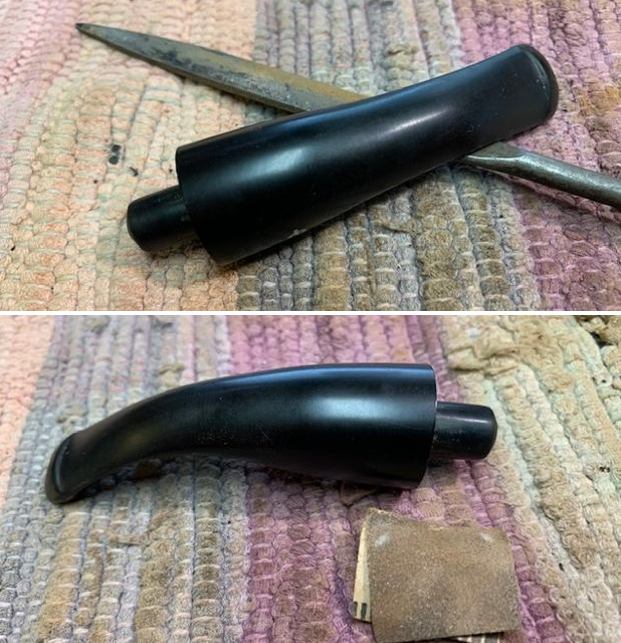 I polished the stem surface and the surface of the tenon with micromesh sanding pads – dry sanding it with 1500-12000 grit micromesh sanding pads. I wiped the stem down after each pad with some Obsidian Oil and finished the polishing it with Before & After Pipe Polish – both Fine and Extra Fine.
I polished the stem surface and the surface of the tenon with micromesh sanding pads – dry sanding it with 1500-12000 grit micromesh sanding pads. I wiped the stem down after each pad with some Obsidian Oil and finished the polishing it with Before & After Pipe Polish – both Fine and Extra Fine.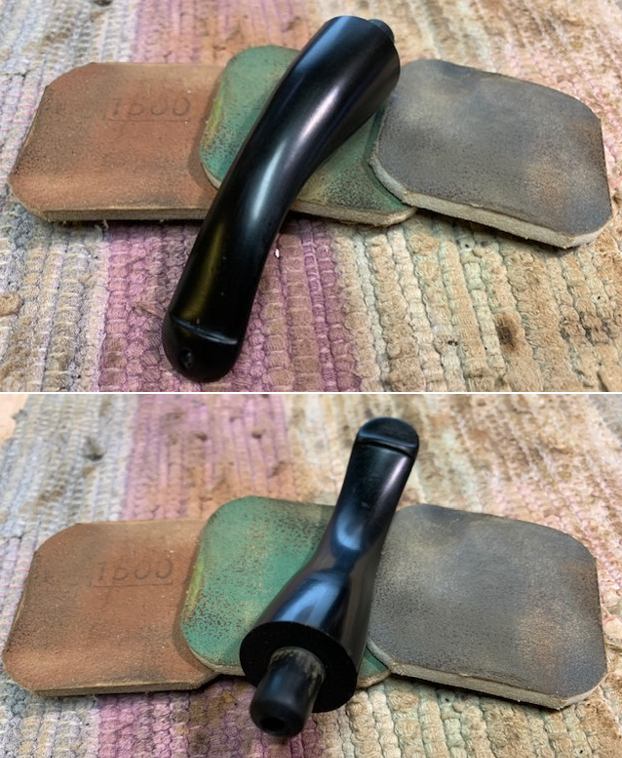
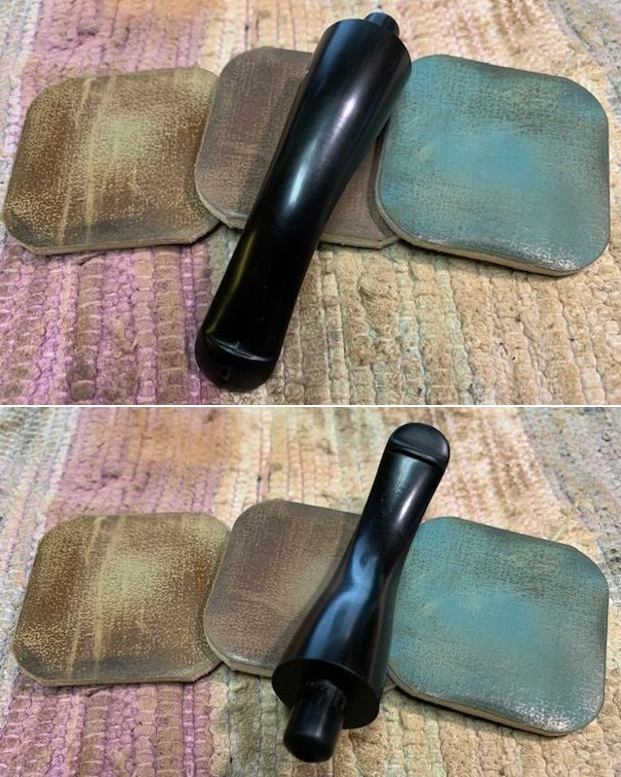
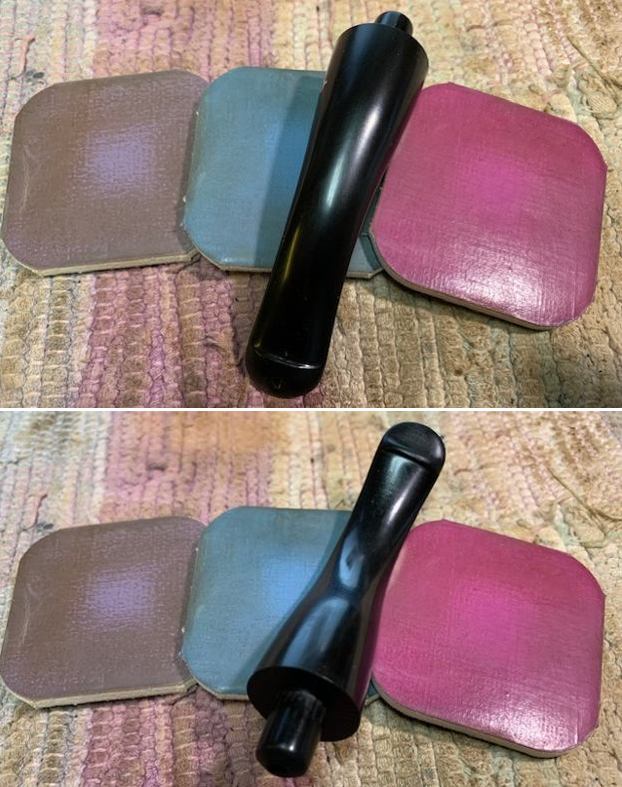
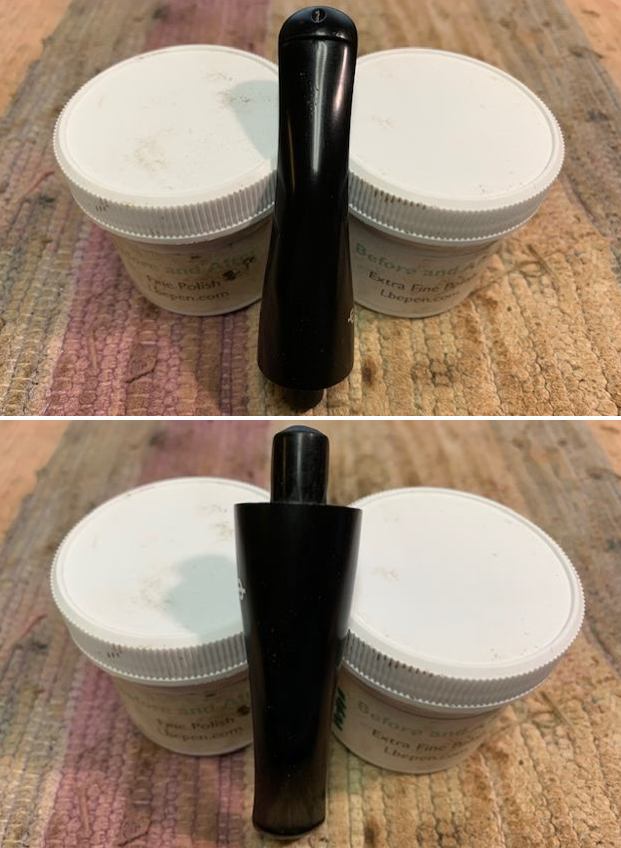 I put the stem on the shank and lightly buffed the bowl and shank with Blue Diamond polish. I used a light touch so as not to get build up in the rustication. I used a heavier touch on the stem. The finished pipe with the properly fitted stem is a beauty. The Peterson Pipe of the Year from 1994 is a 999 shaped Rhodesian. The rusticated finish looks a lot like a Donegal Rocky. The fit of the stem to the shank is now flush and the feel in the hand is perfect. The pipe looks really good and has a rich shine. The dimensions of the pipe are – Length: 6 inches, Height: 1 ½ inches, Outside diameter of the bowl: 1 ¼ inches, Chamber diameter: 7/8 of an inch. The weight of the pipe is 60 grams/2.12 ounces. Give the finished pipe a look. I will be cleaning up my friend’s second pipe then giving him a call so he can pick them up. Thanks for walking with me through the blog. Cheers.
I put the stem on the shank and lightly buffed the bowl and shank with Blue Diamond polish. I used a light touch so as not to get build up in the rustication. I used a heavier touch on the stem. The finished pipe with the properly fitted stem is a beauty. The Peterson Pipe of the Year from 1994 is a 999 shaped Rhodesian. The rusticated finish looks a lot like a Donegal Rocky. The fit of the stem to the shank is now flush and the feel in the hand is perfect. The pipe looks really good and has a rich shine. The dimensions of the pipe are – Length: 6 inches, Height: 1 ½ inches, Outside diameter of the bowl: 1 ¼ inches, Chamber diameter: 7/8 of an inch. The weight of the pipe is 60 grams/2.12 ounces. Give the finished pipe a look. I will be cleaning up my friend’s second pipe then giving him a call so he can pick them up. Thanks for walking with me through the blog. Cheers.